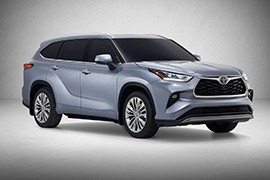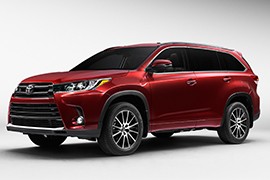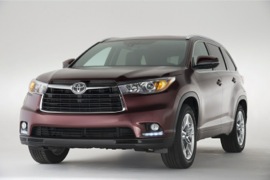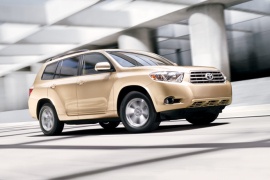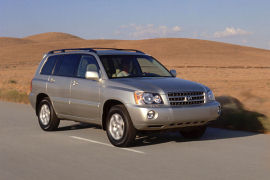TOYOTA Highlander / Kluger Models/Series Timeline, Specifications & Photos
First production year: 2001
Engines: Hybrid, Gasoline, Hybrid gasoline
Body style: SUV (Sports Utility Vehicle)
Toyota introduced the fourth generation of the Highlander at the 2019 New York Auto Show, and it was the carmaker’s answer for the three-row crossovers segment.
The Japanese automaker introduced the Highlander in its lineup in 2000 and pitted it against other mid-size SUVs, such as the Chevrolet Trailblazer and the Jeep Grand Cherokee. Toyota made its newcomer on the same platform as the Lexus RX, and since it had a strong reputation for building reliable vehicles, it sold it in significant numbers. Furthermore, it was also suitable for larger families since it was a three-row vehicle. But fast forward to 2019, when the car reached its fourth generation, and it shined in many areas, including the interior.
Starting at the front, the 2020 Highlander didn’t have the same humble look. Its swept-back LED headlights had an aggressive stance compared to its predecessor. The 2020 Highlander was available in five grades: L, LE, XLE, Limited, and Platinum. The lower grades came with a silver grille, while the upper two versions featured a black pattern and a chromed surrounding. On the sides, the fog lamps were neatly integrated into a set of scoops, while on the apron, the automaker added a second air intake to help cool the engine and a silver body element that mimicked a skid plate. Still, the most striking aspects of the vehicle when viewed from the front were the longitudinal power dome on the hood and the chromed trim that sported the brand’s logo.
From its profile, the three-row SUV looked sporty thanks to its ascending waistline and the sculptured lines from the doors that emerged onto the rear quarter panels. To emphasize the off-road characteristic of the vehicle, Toyota added black plastic trims around the wheel arches and a set of 18-inch light alloy wheels, with an option for a set of 20-inch ones, depending on the grade. The door mirrors featured body-colored caps but black stalks. Finally, at the back, the broad taillights emerged from the quarter panels to the rear fascia onto the raked-forward tailgate.
Inside, the 2020 Highlander was available with two or three-row seating and room for up to eight people onboard. Still, it wasn’t as large as a minivan, but even the rearmost seats could be used for short jaunts. At the front, Toyota installed a touchscreen atop the center stack with a size of up to 12.5 inches and a backup camera. In front of the driver, the Highlander sported a clean-designed instrument cluster that featured a 4.2” TFT between the speedometer and tachometer.
Under the hood, Toyota offered the Highlander a choice of two engines: a 3.5-liter V6 and a hybrid powertrain. The former developed 295 horsepower (300 PS), while the latter brought a total of 240 HP (243 PS) to the table thanks to an inline-four powerplant and two electric motors. Not all versions of the Highlander were fitted with an all-wheel drive system.
Toyota introduced the Highlander/Kluger nameplate in several markets in 2000, and by 2016 it had already launched the facelift for the model's third generation.
Even though it was known as a competitive off-road automaker, Toyota lacked in the mid-size crossover segment. While the RAV4 was an appreciated product all over the world, there was nothing bigger than that. And that convinced the carmaker to produce the Highlander. Unlike the Land Cruiser or the 4Runner, it was built on top of a regular sedan platform, thus creating a more car-like experience for its customers. But it could tackle some grass and snow-covered roads without a problem, thanks to its all-wheel drive system.
The facelifted version of the Highlander's third generation received a completely new front fascia. Its new trapezoidal grille was visually extended down to the lower bumper. Moreover, the fog lamps were nicely installed in the side scoops that also provided some cooling to the front brakes. The side of the vehicle didn't reveal any significant changes, but the rear end shows a new set of LED taillights.
For the interior, the Highlander provided seating for up to eight passengers, with an option for seven seats with captain chairs for the middle row. In addition, the carmaker added leather upholstery fitted as standard for specific trim levels. Moreover, in the safety department, Toyota introduced several critical features such as the lane-keep assist, the bird-eye-view 360 degrees camera system, and a microphone that helped the driver talk and be heard by the kids in the last row.
Under the hood, Toyota installed a choice of gasoline or hybrid drivetrains that sent the power to the front or in all corners via either a newly developed eight-speed automatic transmission or a CVT for the hybrid version.
Toyota rushed the Highlander through generations, and just five years after it launched the model's second iteration, it brought the third one at the 2013 New York International Auto Show.
With the world financial crisis gone, Toyota was more relaxed and aimed high at the mid-size crossover segment with the Highlander. The 2014 model year version of this vehicle showed that the Japanese automaker focused more on design than on the previous two generations of this nameplate. Furthermore, it worked harder to provide an upscale interior and offered customers a vehicle that was no longer made for school runs. As a result, the car sold more than 200,000 units worldwide since it was available in the U.S., Japan, Australia, and China.
While the first two generations of the Highlander didn't look like the automaker invested too much in the design department, the third generation came with a fresh aspect and a bolder look. The headlights were slimmer and swept back towards the fenders and sported projector beams. Between them, the automaker placed a broad grille with a chromed surrounding. In addition, the carmaker's badge was housed at the top, being integrated into a chromed horizontal slat. On the lower side of the bumper, Toyota added a second air intake that improved the cooling area and was flanked by the side scoops for the fog lamps and the daytime running lights.
The flared wheel fenders of the 2014 Highlander looked more subtle, especially for the front axle. Toyota also improved the side design with sculptured door panels that featured a creased lower area just above the side sills. It also used a black trim around the wheel arches and on the bodywork's lower side to emphasize the Highlander's SUV image. The door mirrors now featured turn signals, which was part of the safety package introduced by Toyota. Finally, at the back, the automaker penned a raked-forward D-pillar that created a dynamic image for the car. Finally, at the back, a roof spoiler adorned the tailgate, which integrated parts of the taillights.
Inside, customers were in for a big surprise. The three-row vehicle could accommodate up to eight people, although Toyota offered customers the option to get six seats with two captain seats for the middle row. At the front, the standard bucket seats provided an average side support. The redesigned instrument cluster ditched the binocular style that was previously used and adopted a more classical pattern with a broader panel where the speedometer and tachometer flanked a TFT between them. There was also an improvement in the quality of the materials, which made customers feel better like they were in a premium vehicle.
Under the hood, Toyota carried over the engines from the previous generation. The base model came with a 2.7-liter. The mid-grade version offered customers a 3.5-liter naturally aspirated unit, while the top-spec version featured a 3.5-liter V6. Apart from the hybrid version, which was mated to a CVT, the other versions featured a 6-speed automatic transmission. The all-wheel-drive system was available for selected engines.
After seven years on the market, the Highlander needed a well-deserved new model, which Toyota unveiled as the second generation of this successful crossover at the 2007 Chicago Auto Show.
The Japanese automaker aimed high when it made the Highlander, also known as Kluger, in the Japanese and Australian markets. It was the first in its class to offer a hybrid, gas-electric powertrain that helped reduce running costs. Furthermore, its unibody construction made the vehicle feel like a sedan, not like an SUV. With the introduction of the second generation, Toyota stepped up its game and improved the vehicle in many areas. And unlike the first generation that didn’t come right from the start with three-row seating, this one did.
While the design was not the main asset of the vehicle, the Highlander still impressed many customers with its simple front fascia design that featured clear headlights and a trapezoidal-shaped grille. Depending on the trim level, that was black or silver. On the hood, the automaker made a bulged center section that visually connected the prominent grille to the lower side of the windshield. On the lower bumper, the Highlander featured a pair of clusters that housed the fog lamps.
Toyota kept the idea of a sporty-looking crossover for the Highlander’s second generation and penned flared wheel arches for it. The six-spoke alloy wheels were standard for most of the five trim levels, depending on the engine version. Chromed trims adorned the window line, and similar shiny parts were also available to decorate the side sills. Still, the B- and C-posts were darkened, like on the 2001 Highlander, and the body-colored D-pillar behind made the car look bigger than it was. At the back, the automaker added clear corner-mounted taillights.
But the biggest upgrade was noticed on the interior. The dashboard’s design was slightly more complicated than before, but it still featured the same instrument cluster with a binocular styling for the gauges. The center console housed the controls for the HVAC system and the Infotainment unit. In addition, the automaker added a small information display atop the main screen, between the center vents, that showed other information for the driver, showing which doors are opened or closed, time, and exterior temperature. Thanks to the three row-seating, the Highlander could provide enough room for up to seven people on board. The rearmost row was mostly suitable for kids due to the limited legroom.
Under the hood, Toyota installed a choice of three gasoline engines. The base model came with a 2.7-liter inline-four, while the rest of the range featured either a 3.5-liter V6 or a 3.3-liter hybrid drivetrain. The gas-electric variant also allowed customers to drive the Highlander in EV-only mode at low speeds for short distances. Like its predecessor, the second generation of this crossover was available with either a front or an all-wheel drive system.
Toyota introduced the Highlander nameplate in its inventory and launched the first generation of this mid-sized SUV at the 2000 New York Auto Show, combining the abilities of a crossover with those of a minivan.
While many customers started to switch from minivans to SUVs and crossovers, Toyota had to make a move and provide them with what they were looking for. As a result, it took the platform from the Lexus RX and made a three-row unibody vehicle on top of it. As a result, the 2000 Highlander entered competition with other mid-size SUVs, such as the Chevrolet Trailblazer and the Pontiac Aztek. Even though its newcomer was just slightly larger than the already present Rav4, it enjoyed great success, selling over 80,000 units in the first year. The vehicle was sold in Japan and Australia with the Kluger nameplate. Over the years, the car was constantly updated to meet customers’ demands.
At the front, Toyota installed rectangular headlights on the Highlander/Kluger, featuring halogen lamps. The grille between them was adorned by two horizontal slats where the carmaker’s badge took center stage. Lower, on the bumper, depending on the grade, customers could get a set of round fog lamps mounted on the outer sides. The hood featured a raised center section that connected with the grille.
From its profile, the 2001 Highlander boasted flared wheel arches for both axles, trying to convince customers that it was a sporty crossover. The body-colored door mirrors and handles amplified that sensation, together with the blackened B- and C-posts. Toyota also offered a choice of alloy wheels that improved the crossover’s look. Finally, at the back, the automaker placed a roof spoiler on top of the tailgate.
But the automaker made the Highlander to attract crossovers and minivan buyers alike. As a result, it focused more on the interior. At first, the car didn’t have a connected center console to the dashboard, but that issue was fixed in 2001. Later on, besides the regular CD players and stereos, Toyota also added a sat-nav system mounted atop the center stack. Fronting the driver was an instrument cluster with a binocular-styled system, where the speedometer took center stage in the middle and was flanked by a tachometer on the left and the fuel and temperature gauges on the right binnacle. Depending on the grade, the Highlander came fitted with cloth upholstery. Still, the higher trim levels offered heated leather seats for the front row. The middle row featured a 60/40 split-folding bench seat, while a third row became available in 2004 and was mostly suitable for children.
The technical part was constantly improved. In 2000, the car was offered with two gasoline engines: a 2.4-liter inline-four and a 3.0-liter V6. Later, a hybrid powertrain joined the bandwagon and pushed the car’s limits higher while also improving fuel efficiency. Power went to the front or in all corners of the vehicle via a four-speed automatic transmission.
TOYOTA Highlander 2.4L DOHC AWD 4AT (155 HP)
TOYOTA Highlander 2.4L DOHC AWD 4AT (160 HP)
TOYOTA Highlander 2.4L DOHC FWD 4AT (155 HP)
TOYOTA Highlander 2.4L DOHC FWD 4AT (160 HP)
TOYOTA Highlander 3.0L DOHC AWD 4AT (220 HP)
TOYOTA Highlander 3.0L DOHC FWD 4AT (220 HP)
TOYOTA Highlander 3.3L V6 5AT FWD (230 HP)
TOYOTA Highlander 3.3L V6 AWD 5AT (215 HP)
